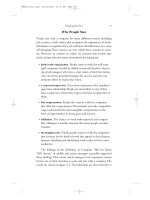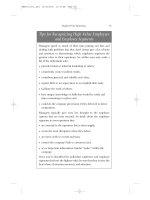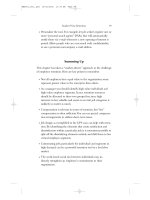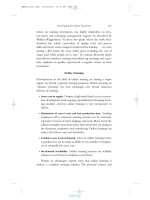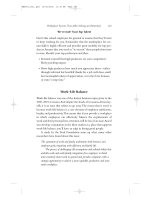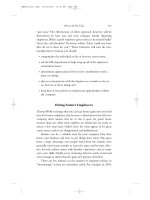Hiring and Keeping the Best People 18
Bạn đang xem bản rút gọn của tài liệu. Xem và tải ngay bản đầy đủ của tài liệu tại đây (111.33 KB, 8 trang )
”Re-recruit” Your Top Talent
Don’t take valued employees for granted or assume that they’ll want
to keep working for you. Remember that the marketplace for cer-
tain skills is highly efficient and provides great mobility for top pro-
ducers.Assume that you need to “re-recruit” these people from time
to time. Identify your top performers and then:
•
Remind yourself that high producers are your competitors’
likely poaching targets.
•
Show high producers how much you appreciate them—either
through informal but heartfelt thanks for a job well done, small
but meaningful tokens of appreciation, or in the form bonuses
or extra “comp time.”
Work-Life Balance
Work-life balance was one of the hottest business topics prior to the
2000–2001 recession.And despite the shock of recession-driven lay-
offs, it is an issue that refuses to go away. The reason that it won’t is
because work-life balance is a core element of employee satisfaction,
loyalty, and productivity.This means that if you provide a workplace
in which employees can effectively balance the requirements of
work and their personal lives, retention will be less of an issue.And if
you develop a reputation in the labor market as a place that supports
work-life balance, you’ll have an edge in hiring good people.
A study by the Ford Foundation sums up what many other
researchers have found about this issue:
The separation of work and family undermines both business and
employee goals, impairing work efficiency and family life.
The process of challenging old assumptions and cultural beliefs that
underlie work and work-family integration frees employees to think
more creatively about work in general and provides companies with a
strategic opportunity to achieve a more equitable, productive, and inno-
vative workplace.
Workplace Factors That Affect Hiring and Retention 123
HBE001_ch6_.qxd 10/02/2002 11:36 AM Page 123
Many of the same assumptions and beliefs that create difficulties in
work-family integration also lead to unproductive work practices, under-
mining the companies’ ability to achieve key business goals.
Restructuring the way work gets done to address work-family
integration can lead to positive,“win-win” results—a more responsive
work environment that takes employees’ needs into account and yields
significant bottom-line results.
1
As this quotation makes very clear, work-life balance isn’t just a
“feel-good” issue or a perk that will cost your company money. It
translates into better business performance.
In the United States, two long-term developments brought the
work-life issue to a head in the late 1990s.The first was the uniquely
American practice of expanding the work year, even as people
became more productive and prosperous. Harvard economist Juliet
Schor in her book The Overworked American has documented how
the typical American has been asked to work more and more hours.
By her count, the average U.S. work year has grown nine hours per
year over the past several decades.
2
Those extra hours (and they
really add up over the years) have cut directly into the time people
would normally spend tending to family and personal matters.
Ironic, isn’t it? The more productive and prosperous Americans
become, the more they are asked to work. By the late 1990s, the
average American manufacturing employee was putting in 320 more
hours each year than his or her counterpart in Europe.
Schor’s research was completed before laptops and e-mail had
made major inroads into corporate life. So you can add into her cal-
culation of long hours the time that people now spend working at
home on weekends and answering e-mails at night and during their
vacations.
The result of working hours escalation: people feel squeezed.
They find themselves in a winless situation in which they must
either shortchange their careers or neglect their home lives. Many
companies have made this situation worse by perversely buffering
up-cycles in the economy with overtime. When business is boom-
ing, they ask people to work extra hours; this helps them to avoid
adding new people to the payroll.
124 Hiring and Keeping the Best People
HBE001_ch6_.qxd 10/02/2002 11:36 AM Page 124
The second big contributor to the issue of work-life balance has
been the growing percentage of married women in the work force.
Today, well over 50 percent of married women are employed outside
the home.That’s good news for gender equity, but having two work-
ing spouses means that fewer people are available to keep up the
household. When both are working full time and tied up in daily
commutes, the time available for family and personal life takes a
major hit. Meals are caught on the fly, and civic and family activities
are shortchanged.
Three Principles
Work-life balance is a major issue today because so many people are
saying “enough” to long days, paltry vacations, evenings spent in
hotel rooms, and weekend e-mails from the boss. Many companies
have gotten the message and responded with programs that help
their employees balance the two sides of their lives.
At first blush, you’d think that every concession toward work-
life balance would represent a cost to the sponsoring company. But
as Stewart Friedman, Perry Christensen, and Jessica DeGroot ex-
plained in a widely read Harvard Business Review article, work-life
balance can be approached from a “win-win” perspective, and not as
a zero-sum game:
[W]e have observed that a small but growing number of managers . . .
operate under the assumption that work and personal life are not
competing priorities but complementary ones. In essence, they’ve
adopted a win-win philosophy.And it appears they are right: in the
cases we have studied, the new approach has yielded tangible payoffs
both for organizations and for individual employees.
3
These researchers offer three principles for breaking through the
zero-sum game:
1.
Make sure that employees understand business priorities and
encourage them to be equally clear about their personal priori-
ties.
The work of the organization must get done, and
work-life balance should not be an excuse for letting it slide.
Workplace Factors That Affect Hiring and Retention 125
HBE001_ch6_.qxd 10/02/2002 11:36 AM Page 125
Alternatively, work cannot be an excuse for letting important
personal matters slide. Friedman, Christensen, and DeGroot
counsel managers to be clear about company goals and per-
formance expectations.At the same time, they encourage
employees to be clear about their goals as family members and
as individuals. Once everyone’s cards are on the table, schedules
and assignments can usually be arranged in ways that satisfy
both sides.“The fact that these managers define business success
in terms of results is key,” they write.“To them, outcomes
matter more than process.To that end, they give their employ-
ees specific goals but also great autonomy over how to achieve
those goals.”
4
2.
Recognize and support employees as “whole people” with
important roles outside the workplace.
Managers can only deal
with work-life conflict if they understand and show some
interest in the nonworking lives of their employees.And show-
ing a sincere interest “creates a bond and, with it, trust—which
brings organizational benefits familiar to any manager.”
5
3.
Continually experiment with how work gets done.
Smart man-
agers know that work processes must be periodically rethought
and redesigned for greater efficiency and effectiveness.Work-
life balance provides opportunities to experiment with these
processes. In describing managers who have successfully
adopted work-life balance, the authors state that “[C]onflicts
between work and personal priorities can actually be catalysts
for identifying work inefficiencies that might otherwise have
remained hidden or intractable.”
6
Does your office have a “this is how we do things” mentality?
That’s bad for the company because it stands in the way of process
improvement. In a dynamic environment, the best way of doing
things is always changing. Flexibility is one of the ways we adapt to
change and survive.
So, according to Friedman, Christensen,and DeGroot, work-life
balance doesn’t have to be a zero-sum game. Managed correctly,
126 Hiring and Keeping the Best People
HBE001_ch6_.qxd 10/02/2002 11:36 AM Page 126
work-life balance can improve morale, increase productivity, and
help you hire and retain the best employees. (See “Tips on Work-
Life Balance.)
Telework
Many companies have found that telework is an effective tool for cre-
ating work-life balance. Telework describes work that is done by
employees in locations other than their regular offices and is facili-
tated by telecommunications and Internet capabilities.The Interna-
tional Telework Association & Council’s (ITAC) definition of tele-
work is “using telecommunications to work wherever you need to
in order to satisfy client needs: whether it be from a home office,
telework center, satellite office, a client’s office, an airport lounge, a
hotel room, the local Starbucks,or from your office to a colleague 10
floors down in the same building.”
7
The ITAC estimated that some
20 million U.S. employees were involved in some form of telework
in 2001.
Proponents of telework point to measurable cost savings and
benefits, including lower real estate costs, greater employee produc-
tivity, greater employee loyalty and job satisfaction, and lower per-
sonnel turnover.And the teleworkers themselves report that it helps
them balance work and personal responsibilities. AT&T, which has
used telework heavily since the early 1990s, conducted a random
survey in 2000 of 1,238 managers and found that:
•
Teleworkers put in more hours. Respondents indicated that
they worked at least one hour more per day; that’s equivalent to
250 hours or 6 weeks of extra (unpaid) work done by the
average teleworker.
•
Telework is more productive. Seventy-seven percent of AT&T’s
teleworkers said that they got more accomplished at home than
they did in the office.
•
Loyalty improves. Of those teleworkers who reported
receiving competing job offers, 67 percent said that giving
Workplace Factors That Affect Hiring and Retention 127
HBE001_ch6_.qxd 10/02/2002 11:36 AM Page 127
TEAMFLY
Team-Fly
®
